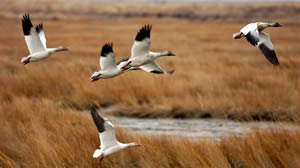What Is a Light Goose Conservation Order?Waterfowl Ecology and Management Program Biologist September 15, 2009 Results of the 2009 Light Goose Conservation Order in the Atlantic Flyway Beginning in spring 2009, many Atlantic Flyway states, including New Jersey, implemented a Conservation Order (CO) for light geese. Given the overabundant population status of these birds, the CO is likely to continue for several more years. So what exactly is a CO and how does it differ from a hunting season?
In response to this problem, the US Fish and Wildlife Service (Service) implemented special regulations for light geese in the Mississippi and Central Flyways in 1999 and initiated an Environmental Impact Statement (EIS) to frame the issue and outline potential solutions. Shortly thereafter, the Service was sued by humane organizations and ultimately withdrew the special regulations. Later in 1999, Congress passed the Arctic Tundra Habitat Emergency Conservation Act which essentially reinstated the special regulations for light geese through emergency Congressional Order. In 2007, the US Fish and Wildlife Service completed the light goose EIS. The EIS examined five alternatives for managing light goose populations, ranging from no action to direct population control by wildlife agencies. All of the proposed alternatives for action in the EIS were drastic and unpalatable to some degree. The consequences of no action, where there would be serious consequences to light geese themselves as well as the myriad of bird species dependent on the same habitats, was not acceptable. The recommended alternative in the EIS was to authorize special regulations, including the use of a Conservation Order, to increase harvest for overabundant light goose populations. A CO is a special management action, authorized by the Migratory Bird Treaty Act that is needed to control a wildlife population when traditional management programs are unsuccessful in preventing overabundance of that population. A CO is authorized through the Service. In November 2008, the Service published the Final Rule to implement the preferred alternative in the EIS. The EIS and Final Rule supersede the Arctic Tundra Habitat Emergency Conservation Act, making the special regulations permanent in the Central and Mississippi Flyways, and also make Atlantic Flyway states, including New Jersey, eligible to implement a light goose CO. The CO is exclusively for "light" geese which is the collective name applied to greater snow geese, lesser snow geese and Ross's geese. In the Atlantic Flyway, greater snow geese are by far the most abundant light goose population although some lesser snow geese and Ross's geese can also be found. Greater snow geese breed in the Eastern Canadian high arctic and winter predominantly in the eastern United States. Key fall and spring migration staging grounds are centered on the Saint Lawrence River Valley in southern Quebec. Recently, the greater snow goose population has grown to record highs and currently number just over one million birds. This level is twice the population objective of 500,000 birds. The intent of the CO is to reduce and ultimately stabilize these North American light goose populations all of which are above population objectives. The CO allows an extended time period outside of traditional hunting seasons as well as additional methods for taking these birds without bag limits. Additional methods for take include the use of electronic calls, unplugged shotguns, and extended hours up to ½ hour after sunset. Standard hunting seasons for migratory game birds are designed to provide recreational opportunities for North American citizens. Under the auspices of the Migratory Bird Treaty Act, annual hunting regulations are intended to keep harvest at levels compatible with a population's ability to maintain itself at a desired population objective. Since there are upper limits to a bird population's ability to withstand harvest, certain regulations, such as bag limits, constraining the number of shot shells in a firearm, banning the use of electronic calls, etc, have been established to limit harvest. However, these same tools (regulations) deemed too effective and therefore banned from hunting seasons, become the same tools to increase harvest under a CO where the objective is to reduce an overabundant population. Thus far, implementation of the CO has met with some success for mid-continent North American light geese. Since implementation of the CO in 1999, the harvest of mid-continent light geese has more than doubled, and the population growth rate as measured by the midwinter index has been reduced. Based on these experiences from the Mississippi and Central Flyways, biologists estimate that the newly enabled CO in the United States portion of the Atlantic Flyway (special regulations have been in place in Quebec since 1999) should increase the continental greater snow goose harvest rate from the current 20% to 26%. If this harvest rate is achieved, the population should be reduced to its goal by about 2013. However, several factors will affect this harvest rate including the size of regular season harvest and the magnitude of special spring harvest measures in Quebec. RELATED INFORMATION
|
||||||||
|
||
|
|
||
|
||
| |
||

